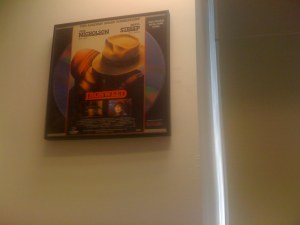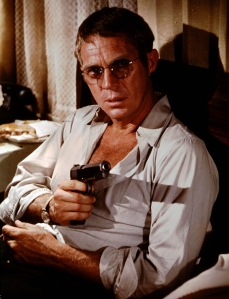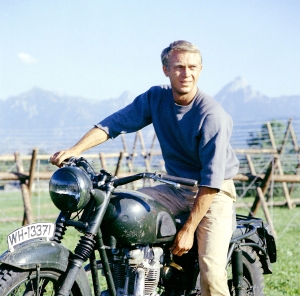
“That’s Ironweed,” Josh Strauss told me.
I admitted I’d never seen it.
“Meryl Streep’s best performance. Jack Nicholson at the top of his game. But impossible to find. Impossible.”
He should know. Strauss, programming associate for Film Society of Lincoln Center, had had a long history trying to find prints, trying to keep them vibrant and in tip-top shape. It’s what he did before he came here for independent distributors in New York and L.A.
“That and acting,” he said. “For about five minutes.”
Mr. Strauss had made a career of loving movies, remembering them in 35 and trying to find the best way they could be shown in a theater.
“Lincoln Center is full of intellectuals,” Mr. Strauss told me. “People doing brilliant work on the aesthetics of film, doing retrospectives on that.” He gave me at least a little bit of a smile. “I can’t offer that. What I can offer are the movies I loved to see when I was a kid.”
Those movies take the form of the series Yesterday’s Loner: Steve McQueen, a retrospective of the actor’s work on films as diverse as Enemy of the People, where he plays a small town doctor fighting to keep pollutants from a river, to The Magnificent Seven, where he embodied a sort of American samurai.
And though McQueen certain has a range, he was known best as a sort of action hero, a cowboy-badass of the type that would later make Clint Eastwood a legend.

“I did a retrospective of Charlton Heston and, well, I’d put him in the same category,” Mr. Strauss said.
His office was lined with the posters of the retrospectives he’d done and the movies he loved, including the one I had been staring at, Ironweed.
“I’m old enough to remember seeing him, seeing Steve McQueen on film.” Strauss recalled. “He was an authority to me in Saturday Afternoon matinees; a power.”
The Steve McQueen series, screening May 20th-26th at the Walter Reade theater, is lined with guest appearances by prominent McQueen collaborators, people like Candice Bergen and Robert Vaughn. “You know, Norman Jewison said The Cincinatti Kid was the first movie that he ever felt like a filmmaker,” Strauss reported. “Now 44 years later, he’ll be back to say that again, introducing the film.”
“Finding prints for movies,” Josh told me, “you just try to show things while they’re there, while they’re good. These prints of Steve McQueen’s films are still good. And people haven’t forgotten him, they just haven’t seen the movies.”
And talking, looking at the man, his posters, his enthusiasm: I felt excited for the chance now.
-Nicholas Feitel
Yesterday’s Loner: Steve McQueen runs from May 20-26 at the Walter Reade Theater. Tickets are on sale now online.













Film Comment reports: McQueen’s Hunger
October 4, 2008“They had successfully created this world like a sphere that, wherever it rolled, would be right.”
-Steve McQueen discussing the actors’ performance in Hunger [watch a short clip of the NYFF press conference here]
Hunger (directed by Steve McQueen) is miraculously well constructed for a debut feature. It vividly (and all-too fecally) details the lives of imprisoned IRA members in a manner (at first) so relentless that the viewer is given no time to take stock of the events from a own perspective or outside of the film’s reality. The flashes of contemporary resonance give it urgency, but the lack of complexity in terms specific current events keep the viewer’s mind constricted to the point of incarceration. The extreme graphic violence (not to mention the political-zombie subtext), oddly recall George Romero, but in McQueen’s case quickly justifies itself before the gruesomeness becomes too much of a diversion. The action-packed first half, a thrill-ride of brutality, comes to a screeching halt, just in time to keep the movie from falling into torture-porn territory. In a 20-minute-long shot of absolute stillness and calm, we enter a zone (a visiting room) of chaperoned contemplation. At this juncture, a classic prison confession scene, the viewer is given a myriad of readymade perspectives to digest everything we’ve just experienced.
Hunger is undeniably impressive in its construction; many critics will call it monumental—and they’re probably right. But, unlike the Hungers of the past, both Knut Hamsun’s and Tony Scott’s, McQueen’s impenetrable perfection of form allows for no leakage of thought. The failures, extreme subjectivities and ambiguities of more open-ended artwork permits slippages in and out of the narrative world, promoting complex and unpredictable responses. The Hunger of ’08 never takes a misstep, and thus the film, with its viewers following closely in tow, can only take one route. In its depiction of both sides of the struggle, McQueen refuses to reveal his hand, thereby playing it all too safe.
Categories: Film Comment, new york film festival, what's on
Tags: Hunger, new york film festival, Steve McQueen
Comments: 2 Comments